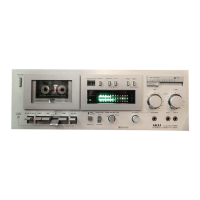Fil!.A
Pull
toward
you both
lower-ends
of
holder.
HEAD CLEANING
1.
Turn
off
Power Switch.
2.
Depress Eject Key and remove cassette
tape
from
receptacle.
The
receptacle lid can be removed by
pulling
both
lower
ends
of
the
lid
toward
you.
Refer
to
Figure A.
•
Be
sure
to
use
both
hands.
3. With cassette
holder
at ejected position, clean heads
with
a
cotton
swab stick which has been dipped
in
Akai Cleaning Fluid (Akai Cleaning Kit HC-5 5
OP).
Also clean
pinch
wheel, capstan, and
other
parts
over wl!ich
the
tape
travels. Refer
to
Figure
B.
4. To replace lid
onto
holder,
hook
the
upper
part
of
the
lid
and
fit
the
lower
part
of
the
lid
onto
holder.
Refer
to
Figure D.
•
If
Akai
Cleaning
Fluid
is
not
available,
use
alcohol.
Do not
use
other
chemical
cleaners
as
the
rubber
parts
will
de-
teriorate.
•
Do
not
insert
cassette
tape
with
receptacle
lid
off.
•
The
receptacle
lid is
properly
attached
when
it
is
even
with
the
front
panel.
HEAD DEMAGNETIZING
The
steel pole pieces which form
part
of
the
recording
and
playback
heads
become
slightly magnetized
after
several recording and
playback
hours
and
as
a result,
the
tape
is partially erased at high frequencies. There-
fore, head demagnetizing is
recommended
periodically.
1.
Turn
off
Power
Switch.
2. Remove cassette
tape
from receptacle.
3. With cassette receptacle at ejected
position,
remove
receptacle
lid
as
in
HEAD
CLEANING
procedure.
4. Demagnetize heads
and
other
parts which
contact
the
tape
with
a Head Demagnetizer
by
bringing
the
prongs
of
the
demagnetizcr
close
to
the
heads
and
withdraw
by
making small circular
motions
over
the
entire
hcad
block
area. Please read
the
instructions
accompanying
the
demagnetizer carefully.
TAPE ERASING
Any signals previously recorded
on
the
tape will be
automatically
erased
as
a new recording
takes
place.
For
erasing
only,
no
plugs should be
connected
to
the
input
jacks and Recording Level Controls should be
kept
at
minimum.
For
quick and
complete
erasure,
a bulk
tape
eraser is
recommended.
LUBRICATION
Although
thiS machine has been sufficiently oiled
for
prolonged use,
for
maximum
service and
optimum
performance,
please
take
your
machine
to
your
local
authorized
AKA! agent
for
occasional
motor
lubrica-
tion.
TROUBLE SHOOTING
The
conditions
hsted below
do
not
indicate mechanical
failure
of
your
unit.
If
your
machine exhibits any
of
these conditions, check
for
trouble
as
indicated.
Recording
Key
will
not
function
'"
Cassette is
not
loaded.
* Cassette
break-out
tabs are removed. Plug
or
cover
cavities.
Tape
will
not
run
*
Power
is
not
being supplied. Check
power
cord
and
Power Switch.
'"
Tape
slack.
Take
up
slack as
mentioned
in Operat-
ing Precautions.
Noisy
Sound
* Heads are magnetized. Demagnetize following head'
demagnetizing instructions.
Hooking Illustration
* Heads are dirty. Clean following head cleaning
instructions.
*
Connections
are
incorrect.
* Wrong
Tape
Selector Position.
Position
according
to
the
kind
of
tape
being used.
Previons recording will
not
erase
'"
Erase head
dirty.
Clean foHowing head cleaning
instructions.
Distorted
Sound
* Recording Level is
too
high.
Turn
Recording Level
down.
Playback
cannot
be effected
*
Connections
are
incorrect.
* Controls are
not
properly
adjusted
or
positioned.
Check
external
amplifier controls.
* Pause Key is depressed.
Recording will
not
take place
*
Dirty
head.
Clean following head cleaning instruc-
tions.
'"
Connections
are
incorrect.
*
Controls
are
not
properly
positioned
or
adjusted.
Check
external
source controls.
* Pause Key
is
depressed.
Should
there
be a
problem
with
your
machine, write
down
the
model
and serial
numbers
and all
pertinent
data
regarding
warranty
coverage as well
as
a clear
description
of
the
existing
trouble
and
contact
your
nearest
authorized
Akai Service
Station
or
the
Service
Department
of
Akai
Company,
Tokyo,
Japan.
[I]

